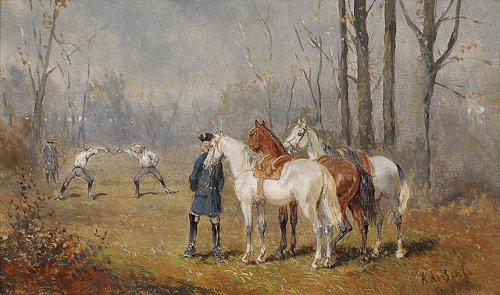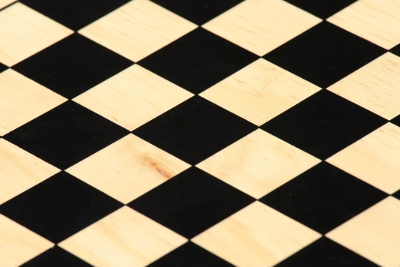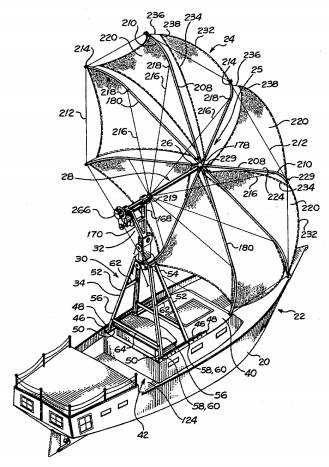
The word bid has vertical symmetry in lowercase and horizontal symmetry in uppercase.
(Thanks, Joseph.)

The word bid has vertical symmetry in lowercase and horizontal symmetry in uppercase.
(Thanks, Joseph.)

The earth goes on the earth glittering in gold,
The earth goes to the earth sooner than it wold;
The earth builds on the earth castles and towers,
The earth says to the earth, All this is ours.
— Inscription on the ruined gate at Melrose Abbey, Roxburghshire, Scotland

In studying the parasitic protozoan Plasmodium ovale in 1954, English parasitologist William Cooper volunteered to receive the bites of about a thousand mosquitos, and nine days later underwent a laparotomy in which a piece of his liver was removed. On recovering, he stained the sections himself, located the malaria parasite stages in his own tissue, and painted these in watercolors to accompany the resulting article.
His coauthor, University of London protozoologist Cyril Garnham, wrote that Cooper “attained everlasting fame by this episode.”
(P.C.C. Garnham et al., “The Pre-Erythrocytic Stage of Plasmodium Ovale,” Transactions of the Royal Society of Tropical Medicine and Hygiene 49:2 [March 1955], 158-167) (Thanks, Andrew.)

effigiate
v. to represent by a picture or sculpture

Ben Franklin considered dueling a senseless practice, as “whichever is killed the point in dispute remains unsettled”:
To this purpose they have a pleasant little story here. A gentleman in a coffee-house desired another to sit further from him. ‘Why so?’ ‘Because, sir, you stink.’ ‘That is an affront, and you must fight me.’ ‘I will fight you if you insist upon it; but I do not see how that will mend the matter. For if you kill me, I shall stink too; and if I kill you, you will stink, if possible, worse than you do at present.’
(From a letter to Thomas Percival, July 17, 1784.)

John Brunner’s 1965 science fiction novel The Squares of the City concerns a South American metropolis in which two opposing political leaders direct the actions of their followers using “subliminal perception.”
In an afterword, Brunner revealed that he had organized the entire plot to follow a historic chess game, Steinitz-Tchigorin Havana 1892. Each of the 32 pieces and pawns corresponds to a character in the book, and every capture in the Steinitz-Tchigorin game corresponds to an event in the plot. For example, Felipe Mendoza, representing the black king’s bishop, is killed in a duel with Luis Arrio, who represents the white queen’s knight. In the game, Steinitz captured Tchigorin’s king’s bishop with his queen’s knight on move 22.
“The individuals who correspond to the ‘pieces’ have powers roughly commensurate with those of the pawns and officers they represent,” Brunner explained. “The moves are all there, in their correct order and — so far as possible — in precise correspondence with their effect on the original game. That is to say, support of one piece by another on its own side, threatening of one or more pieces by a piece on the other side, indirect threats and the actual taking of pieces, are all as closely represented as possible in the development of the action.”
The book was nominated for the Hugo Award for best novel in 1966.

Peter Krovina’s “sailing system,” patented in 1981, replaces a conventional sail with an adjustable windmill — while it’s driving the boat forward, it’s also storing power in batteries.
The batteries serve the boat’s need for electricity, powering the running lights, the cabin lights, space heaters, and the cooking stove.
Best of all, they eliminate the need for an engine — an electric motor drives the screw.

[I]n music, unlike painting, there is no such thing as a forgery of a known work. There are, indeed, compositions falsely purporting to be by Haydn as there are paintings falsely purporting to be by Rembrandt; but of the London Symphony, unlike the Lucretia, there can be no forgeries. Haydn’s manuscript is no more genuine an instance of the score than is a printed copy off the press this morning, and last night’s performance no less genuine than the premiere. Copies of the score may vary in accuracy, but all accurate copies, even if forgeries of Haydn’s manuscript, are equally genuine instances of the score. Performances may vary in correctness and quality and even in ‘authenticity’ of a more esoteric kind; but all correct performances are equally genuine instances of the work. In contrast, even the most exact copies of the Rembrandt paintings are simply imitations or forgeries, not new instances, of the work. Why this difference between the two arts?
— Nelson Goodman, Languages of Art, 1968
A gram is the mass of one cubic centimeter of water; the earth’s gravitational attraction is approximately 10 in metric units (9.8 meters/second2); and atmospheric pressure works out to about 1 kilogram per square centimeter.
This shows that the pressure under 10 meters of water is about one atmosphere. Ten meters of water is 1000 centimeters, so a column one centimeter square would weigh one kilogram and exert a pressure of 1 kilogram per square centimeter.
(Thanks, Steve.)